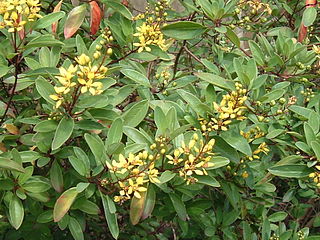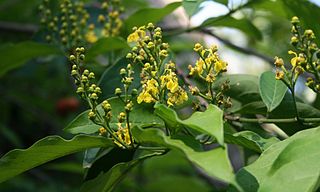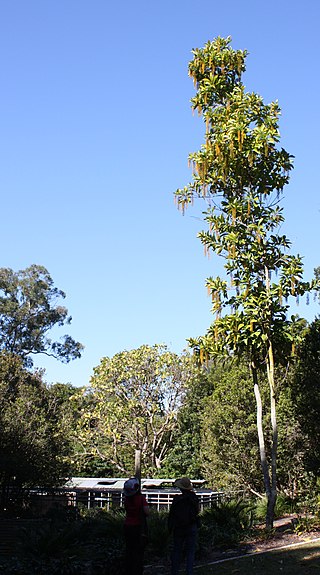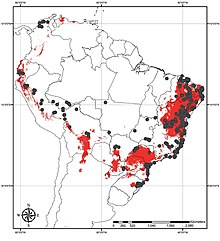
August Heinrich Rudolf Grisebach was a German botanist and phytogeographer.

Malpighiaceae is a family of flowering plants in the order Malpighiales. It comprises about 73 genera and 1315 species, all of which are native to the tropics and subtropics. About 80% of the genera and 90% of the species occur in the New World and the rest in the Old World.

Mezia is a genus in the Malpighiaceae, a family of about 75 genera of flowering plants in the order Malpighiales. Mezia comprises 10 species of woody vines and lianas native to South America, with one species extending into Panama.
Carolus is a genus in the Malpighiaceae, a family of about 75 genera of flowering plants in the order Malpighiales. Carolus comprises six species of woody vines native to Mexico, Central America, the Lesser Antilles, and South America.

Acmanthera is a genus in the Malpighiaceae, a family of about 75 genera of flowering plants in the order Malpighiales. Acmanthera comprises 7 species of trees, shrubs, or subshrubs native to Brazil.
Rhynchophora is a genus in the Malpighiaceae, a family of about 75 genera of flowering plants in the order Malpighiales. Rhynchophora comprises two species of slender woody vines native to Madagascar. The distinctive three to four-winged fruit resembles a helicopter and is unique in the family.
Barnebya is a genus in the Malpighiaceae, a family of about 75 genera of flowering plants in the order Malpighiales. Barnebya comprises 2 species of trees and woody vines native to eastern Brazil. The genus is named in honor of the American botanist Rupert Charles Barneby (1911–2006).

Peixotoa is a genus in the Malpighiaceae, a family of about 75 genera of flowering plants in the order Malpighiales. Peixotoa comprises 29 species of vines, shrubs, and subshrubs native to Brazil and adjacent Paraguay and Bolivia.

Galphimia is a genus in the Malpighiaceae, a family of about 75 genera of flowering plants in the order Malpighiales; the name is an anagram of Malpighia.Galphimia comprises 26 species of large herbs, shrubs, and treelets. Twenty-two species occur in Mexico, one extending into Texas and one ranging to Nicaragua; four species occur in South America, south of the Amazon Basin. Galphimia gracilis is widely cultivated in warm regions throughout the world. Eight species are distinctive in that the petals become stiff and papery, and persist past the stage of fruit maturation.

Bunchosia is a genus in the Malpighiaceae, a family of about 75 genera of flowering plants in the order Malpighiales. It contains roughly 75 species of trees and shrubs, which are native to dry woodlands, savannas, and wet forests. Their range extends from Mexico and the Caribbean to southeastern Brazil and adjacent Argentina. Bunchosia is one of three arborescent genera of Malpighiaceae with fleshy, bird-dispersed fruits.

Mascagnia is a genus in the Malpighiaceae, a family of about 75 genera of flowering plants in the order Malpighiales. The genus Mascagnia comprises about 45 species that occur in diverse habitats from northern Mexico and the Caribbean to northern Argentina and south-eastern Brazil.
Ptilochaeta is a genus of plants in the family Malpighiaceae.

Lophanthera is a genus in the Malpighiaceae, a family of about 75 genera of flowering plants in the order Malpighiales. Lophanthera comprises 5 species of shrubs and trees, all but one native to the Amazonian South America; the exception is from Costa Rica. Lophanthera lactescens has become popular in recent decades as a cultivated ornamental in many warm regions of the Old and New World. It is propagated by cuttings and seeds.

Ectopopterys is a genus in the Malpighiaceae, a family of about 75 genera of flowering plants in the order Malpighiales. Ectopopterys contains only one species of woody vines native to lowland wet forests of Colombia, Ecuador, and Peru.
Mcvaughia is a genus in the Malpighiaceae, a family of about 75 genera of flowering plants in the order Malpighiales. Mcvaughia contains only one species, Mcvaughia bahiana, a shrub occurring in open shrubby vegetation (caatinga) on sandy soils of lowland Bahia, Brazil. It is related to Burdachia and Glandonia.

Callaeum is a genus in the Malpighiaceae, a family of about 75 genera of flowering plants in the order Malpighiales. Callaeum comprises 11 species of woody vines and shrubs occurring from western Texas to Mexico, Central America, and South America. Two species, C. macropterum and C. septentrionale are cultivated as ornamentals in Arizona and California.
Christianella is a genus in the Malpighiaceae, a family of about 75 genera of flowering plants in the order Malpighiales. Christianella comprises 5 species of woody vines and shrubby habit occurring in forests, roadside thickets, and shrubby savannas in southeastern Mexico, Central America, and South America.
Jubelina is a genus in the Malpighiaceae family, a family of about 75 genera of flowering plants in the Malpighiales order. Jubelina comprises six species of woody vines that occur in tropical wet primary and secondary forests of Central America and South America.
Calcicola is a genus in the Malpighiaceae, a family of about 75 genera of flowering plants in the order Malpighiales. Calcicola comprises 2 species of shrubs or treelets native to Mexico.
Digoniopterys is a genus in the Malpighiaceae, a family of about 75 genera of flowering plants in the order Malpighiales. Digoniopterys contains only one species, Digoniopterys microphylla, a shrub known only from shrubby vegetation on sand dunes near the southwestern coast of Madagascar.











